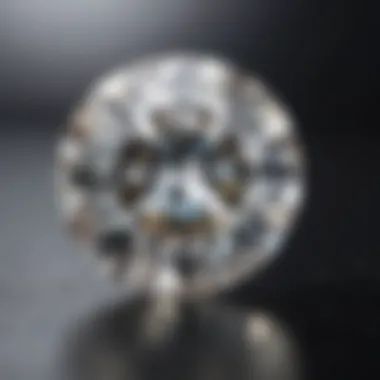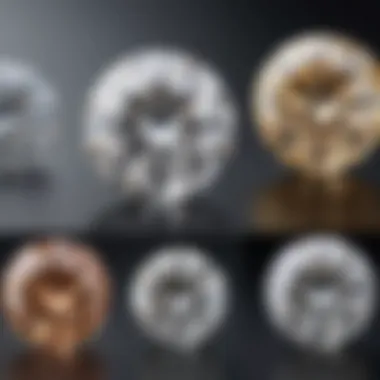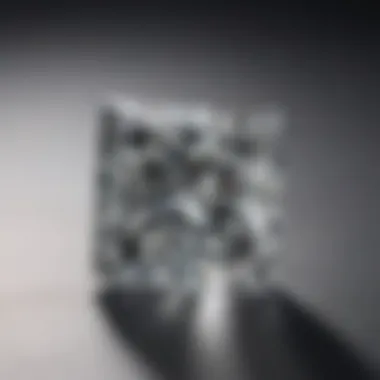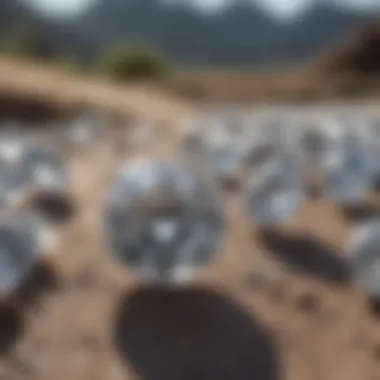Exploring the Best Cut Moissanite: A Comprehensive Analysis


Intro
The allure of moissanite is hard to ignore. As a diamond alternative, it has become increasingly popular in recent years. This article takes a closer look at the factors that impact its aesthetic and market standing, with a special emphasis on the cut of moissanite. The cut not only influences the stone's brilliance but also defines its uniqueness. In the following sections, we will explore the origins, properties, and varying cut styles of moissanite. We will also provide practical advice on how to select the best moissanite stones, along with insights into the ethical aspects of their sourcing.
Gemstone Overview
Definition and Characteristics
Moissanite is a gemstone born from silicon carbide. It resembles diamond closely but has distinguishing traits. Its hardness ranks at 9.25 on the Mohs scale, making it one of the toughest gemstones available. The stone’s refractive index is notably higher than that of diamonds, giving it more brilliance and fire. Collectors and jewelry designers appreciate these characteristics, as they enhance the aesthetic appeal of pieces.
Classification of Gemstones
Gemstones are classified based on several factors, including origin, chemical composition, and crystal structure. Moissanite falls under the category of synthetic gemstones. Unlike natural stones that are mined, moissanite is created in laboratories, ensuring consistency in quality and ethics.
- Natural Gemstones: Formed through geological processes, requiring extensive time to develop.
- Synthetic Gemstones: Lab-created, displaying similar properties to natural stones but made for sustainability and quality control.
By understanding these classifications, enthusiasts can appreciate moissanite's unique place in the broader spectrum of gemstones.
Properties of Gemstones
Physical Properties
Moissanite exhibits several physical properties that make it distinct:
- Hardness: Rated at 9.25, it rivals diamonds in durability.
- Refractive Index: Between 2.65 and 2.69, offering exceptional flash and sparkle.
- Dispersion: Greater than diamonds, leading to more vibrant color flashes.
These features make moissanite a suitable option for various jewelry applications. Designers can use it in engagement rings, earrings, and more without worrying about scratches or damage.
Chemical Properties
From a chemical perspective, moissanite is primarily composed of silicon and carbon. Its structure allows for the formation of cubic crystal habits similar to diamond. Moreover, the manufacturing process can often modify impurities to achieve desired colors and clarity. Understanding these chemical properties aids both collectors and designers in making informed choices about which moissanite options best suit their needs.
"Knowledge of gemstone properties not only enhances appreciation but also guides selection in the market."
By exploring the fundamental aspects of moissanite and its properties, the groundwork is laid for navigating its various cuts. The following sections will dive into how each cut can affect the overall appearance, brilliance, and value of moissanite stones.
Foreword to Moissanite
The exploration of moissanite begins with its unique attributes that distinguish it as a gemstone. Understanding moissanite provides insight into why it has become a preferred alternative to diamonds for many jewelers and customers alike. Coined from the name of its discoverer, moissanite carries the promise of beauty and durability. Its remarkable optical properties play a crucial role in jewelry, making its cut an essential aspect to consider in any analysis.
This section will cover the historical context and characteristics of moissanite. By doing so, we can appreciate its transition from a natural to a synthetic gemstone and its chemical foundation. Moissanite's properties offer distinct advantages over diamonds, making it an intriguing choice for the discerning collector or jewelry designer.
Historical Context
Discovery of Moissanite
Moissanite was first identified by the French chemist Henri Moissan in 1893. He discovered the mineral while investigating samples from a meteor crater in Arizona. This original finding linked moissanite to cosmic origins, which adds a layer of intrigue. The rarity of natural moissanite means that most stones on the market are synthetic, developed to replicate the mineral's unique sparkle.
The key characteristic of the discovery lies in its initial association with extraterrestrial materials. This appeal makes moissanite a popular choice among gemstone enthusiasts who appreciate its unique place in geological history. It proves that even gemstones can have extraordinary origins.
Evolution from Natural to Synthetic
The shift from natural to synthetic moissanite occurred due to the scarcity of the mineral in significant quantities. With technological advances, scientists began to create moissanite in laboratories by replicating the conditions under which it forms naturally. The process ensures consistent quality and purity, making synthetic moissanite a reliable option for consumers.
The major benefit of this synthetic evolution is accessibility. Customers can acquire high-quality moissanite at a more affordable price. However, some purists might argue that synthetic versions lack the authenticity of natural stones. Despite this, the popularity of synthetic moissanite continues to grow as people appreciate its brilliance without ethical concerns about mining practices.
Characteristics of Moissanite
Chemical Composition
Moissanite primarily consists of silicon carbide, a compound responsible for its exceptional hardness. The presence of carbon atoms bonded with silicon lends moissanite its stunning light performance. This specific chemical makeup contributes to its appeal as a gemstone that can withstand daily wear and tear while exhibiting an impressive visual spectacle.
The notable attribute of moissanite's chemical composition is its hardness, rating at 9.25 on the Mohs scale. This feature positions it as a durable alternative to diamonds. In this context, moissanite emerges as a strategically beneficial choice for consumers seeking longevity in their jewelry purchases.


Physical Properties
Physically, moissanite exhibits several unique attributes that set it apart from other gemstones. It possesses a high refractive index and great light dispersion, resulting in an exceptional brilliance and fire. The physical durability of moissanite ensures it remains resilient through everyday use.
Its key characteristic in this category is the optical performance, which exceeds that of many other gemstones. For individuals seeking a stone that offers both beauty and longevity, the physical properties of moissanite make it a compelling option.
Comparison with Diamonds
When comparing moissanite with diamonds, several aspects stand out. While diamonds have long been celebrated for their sparkle and status, moissanite offers many of the same attributes, often at a lower cost. One significant differentiation lies in the appearance of the stones; moissanite generally shows a different light dispersion, leading to more colorful flashes compared to diamonds.
Another important aspect is the ethical consideration involved in sourcing. Moissanite, particularly synthetic varieties, raises fewer questions about miners' rights and environmental impact. Thus, for those concerned with sustainable practices, moissanite often emerges as a superior choice.
Understanding Gem Cuts
Understanding gem cuts is crucial in evaluating the overall quality and beauty of moissanite. The term "cut" refers not only to the shape of the stone but also to how well the facets are executed. A precise cut can enhance the brilliance and overall aesthetic appeal of the moissanite, making it a focal point in jewelry.
The Importance of Cut Quality
Definitions and Terminology
In the context of gemology, the term "cut quality" encompasses several criteria that determine how the stone will reflect light. These include proportions, symmetry, and polish quality. Each term plays an essential role in assessing a stone's cut. Proportions refer to the dimensions of the stone's various facets and how they relate to each other. Symmetry deals with how aligned the facets are, and polish indicates the smoothness of the surface.
Understanding these definitions is beneficial for anyone looking to invest in moissanite. A well-cut stone will typically show superior brilliance, making it more desirable.
Impact on Light Performance
The cut significantly influences light performance. A well-executed cut allows light to enter, reflect internally, and escape through the top of the stone, resulting in a brilliant display. Misproportioned cuts can lead to light leakage, diminishing the gem's brilliance.
Highlighting this aspect makes it clear why cut quality is an essential consideration when purchasing moissanite. Stones that showcase optimal light performance tend to be more valued and appreciated by collectors and enthusiasts alike.
Common Cut Styles for Moissanite
When choosing moissanite, understanding the various cut styles available helps buyers make informed decisions. Each cut style has unique visual characteristics, which can appeal to different tastes and preferences.
Round Brilliant Cut
The Round Brilliant Cut is the most popular style among consumers. This cut consists of 58 facets designed to maximize brilliance and fire. Its symmetrical nature enhances the reflection of light, leading to a stunning visual appeal. Because of its universal appeal and proven track record in performance, the Round Brilliant Cut is often regarded as a favorable choice for engagement rings.
Princess Cut
The Princess Cut is another favored style, known for its contemporary look and sharp lines. This cut retains a significant amount of rough material, which can be advantageous from a cost perspective. The facets on a Princess Cut stone allow for substantial brilliance, making them a popular option for individuals seeking a modern gemstone.
Cushion Cut
The Cushion Cut has a vintage charm characterized by its rounded corners and larger facets. This deep cut enhances the gem’s fire, offering a romantic and classic appearance. Its unique shape makes it a compelling option for those who appreciate timeless beauty.
Oval Cut
The Oval Cut comprises elongated facets that create an elegant appearance. One of its advantages is that it tends to appear larger than its carat weight, making it a popular choice for buyers looking for an impressive-looking gem without a steep price tag. The Oval Cut can also flatter longer fingers beautifully.
Emerald Cut
The Emerald Cut stands apart with its rectangular shape and step-cut facets. This cut emphasizes clarity and color rather than brilliance. The large open facets create a unique optical effect, and it is well-suited for someone who values understated elegance. However, the Emerald Cut does require a high-quality stone, as inclusions and imperfections are more noticeable in its large planes.
Understanding these common cut styles is important for those who wish to find the perfect moissanite. Buyers can select based on their aesthetic preferences and the type of jewelry they envision.
Brilliance and Fire in Moissanite
Brilliance and fire are essential attributes of moissanite that significantly enhance its appeal. These factors determine how a stone interacts with light, contributing to its visual splendor. Understanding these elements is crucial for anyone looking to appreciate or purchase moissanite.
What is Brilliance?
Brilliance refers to the brightness that results from light reflecting off a diamond or gemstone's surfaces. It is measured based on how effectively the stone returns light to the viewer’s eye. This characteristic is essential because it directly affects the perceived value and attractiveness of a gemstone.
Definition and Measurement


Brilliance is quantified using specific measurements. The most common method involves assessing the amount of light that reflects back through the table of the stone—a flat top surface. When evaluating moissanite, its brilliance is generally higher than that of typical diamonds. The high refractive index of moissanite, which is around 2.65-2.69, leads to superior light reflection. This means that moissanite can appear brighter and more luminous than other gemstones.
One unique feature of brilliance in moissanite is often termed as "fire". The way moissanite disperses light can create a flashy appearance, attracting attention in various lighting settings. However, some may argue that too much brilliance can overshadow the subtleness typical of natural stones.
Differences Between Moissanite and Other Stones
When comparing brilliance between moissanite and other gemstones, it is crucial to focus on the refractive indices. For instance, diamond has a refractive index of approximately 2.42. While diamonds are still considered the benchmark for brilliance, moissanite's properties make it a strong competitor. This makes moissanite a favorable choice for those seeking affordable brilliance.
Moissanite's brilliance also has its disadvantages. While it can be more brilliant than diamonds, some people prefer the softer glow of a diamond, noting that moissanite can appear overly flashy.
Understanding Fire
Fire refers to the colorful flashes of light that occur when a gemstone disperses light. This element plays a vital role in how a stone captivates the viewer. Fire adds to the aesthetic beauty of moissanite, making it even more desirable in jewelry.
Scientific Basis of Fire
Fire in gemstones occurs due to the material's ability to separate light into its spectral colors. This phenomenon is closely tied to the gemstone's dispersion rate. Moissanite has a dispersion rate of about 0.104, which exceeds that of diamond's 0.044. This characteristic allows moissanite to exhibit more vibrant colors than diamonds, resulting in eye-catching visual effects.
The scientific basis behind fire is fundamentally important. It explains why moissanite can provide a display of colors without losing clarity. For many collectors and consumers, the vivid expressions of color in moissanite gems enhance their overall appeal.
Comparison of Fire in Moissanite versus Diamonds
When comparing moissanite and diamonds in terms of fire, it becomes apparent that moissanite often outshines diamonds. The stronger dispersion allows for a wider range of color flashes, which can be particularly stunning under specific lighting conditions.
However, this heightened fire can lead to some criticism. For individuals who favor understated elegance, diamonds may be preferred over the more vivid characteristics of moissanite. Ultimately, the comparison comes down to personal preferences, with some opting for the lively displays of moissanite, while others appreciate the classic allure of diamonds.
"In the world of gemstones, brilliance and fire are keys to unlocking a stone's full potential. Moissanite’s unique properties provide an alternative that stands out!"
Selecting the Best Cut Moissanite
Selecting the right cut moissanite is essential for achieving both beauty and quality in your jewelry. The cut of a moissanite directly influences its overall appearance, light performance, and brilliance, making it a crucial aspect for both consumers and jewelers. Each cut style varies, creating distinct visual effects that can enhance or diminish the stone's appeal.
Moreover, understanding how to evaluate moissanite cuts can guide customers in making informed purchases. This section aims to articulate the key elements surrounding the selection of cut moissanite and the benefits it brings.
Evaluating Quality
Criteria for Assessment
When assessing the quality of moissanite, several criteria play significant roles. One critical aspect is the precision of the cut. A well-executed cut maximizes brilliance and fire, allowing the stone to reflect light effectively. Additionally, symmetry is important; any imbalance can lead to less light return, diminishing the gem’s overall sparkle.
Color grading is another vital factor; moissanite ranges from colorless to near-colorless, influencing its desirability. Finally, clarity is essential, as fewer inclusions mean a more valuable stone. These criteria ensure that buyers can appraise moissanite’s true beauty and quality.
Role of Certification
Certification serves as an assurance of quality in the gemstone market. Having a moissanite certified by an established grading organization is a key characteristic that adds credibility to a purchase. Certificates document details such as cut, clarity, and color, helping buyers understand the value of what they are purchasing.
The advantage of certification lies in the peace of mind it provides. Consumers can trust that they are acquiring an authentic gem at a fair price. However, it is essential to recognize that not all certifications carry equal weight; choosing well-regarded organizations is crucial.
Practical Tips for Purchase
Choosing Retailers
Selecting reputable retailers is paramount to acquiring high-quality moissanite. Reliable jewelers often provide warranties, certifications, and excellent customer service. This can ensure a smoother purchasing process and can protect your investment.
A significant characteristic of trustworthy retailers is their transparency about product information and return policies. Such features can help consumers feel more secure in their choices. However, it is wise to conduct thorough research, as not every store meets high standards, leading to potential buyer's remorse.
Understanding Price Variations
Awareness of price variations in moissanite is critical for savvy shoppers. Prices can differ depending on factors such as cut quality, size, and retailer reputation. Understanding these nuances can help buyers gauge whether a price is reasonable or inflated.
One unique feature of these price variations includes understanding how market demand influences costs. However, customers must balance factors like quality against price to avoid under or overpaying.
"A well-selected cut can transform moissanite from a mere gemstone to a lasting treasure, reflecting beauty and personal style."


In summary, discerning the nuances of cut quality, supporting the purchase with verified certifications, choosing reputable retailers, and navigating the pricing landscape form the bedrock of a wise moissanite selection process.
Current Trends in the Moissanite Market
The moissanite market has seen significant changes in recent years. As more consumers become aware of this alternative to diamonds, various trends shape how moissanite is perceived and purchased. These trends highlight the growing interest in ethical practices, evolving consumer preferences, and the aesthetics of moissanite jewelry.
Rising Popularity
Consumer Preferences
Consumer preferences are shifting dramatically in favor of moissanite due to its affordability and brilliance. Many individuals are now prioritizing value without sacrificing appearance. Moissanite offers a less expensive option compared to diamonds while still providing exceptional fire and scintillation.
In particular, the desire for unique jewelry pieces drives these preferences. Especially among millennials and Gen Z, there is a turn towards customization and personalization. Moissanite fits well into this trend because it allows for diverse cuts and settings, making each piece distinct. This personal touch makes moissanite a popular choice, especially for engagement rings.
Shifts in the Jewelry Market
The jewelry market is also adapting to these new consumer trends. There is a noticeable shift towards sustainable and ethical sourcing. More brands are focusing on transparency regarding the origins of their gemstones. Moissanite, being a lab-created stone, aligns with these ideals. Its production has a reduced environmental impact compared to traditional mining.
Moreover, the rise of e-commerce plays an essential role in the accessibility of moissanite. Consumers can now shop for different styles and cuts online. This shift enables better price comparison and encourages buyers to choose moissanite for its brilliance and value.
Ethical Considerations
Sourcing Practices
Ethical sourcing is a critical aspect of the moissanite market today. As consumers become more socially conscious, the demand for responsibly sourced gifts is rising. Moissanite's lab-created nature allows for sustainable practices, eliminating concerns related to conflict minerals and exploitative labor conditions.
Companies that specialize in moissanite often emphasize their commitment to ethical sourcing in marketing. By choosing a moissanite, consumers can feel confident they are making a responsible choice without compromising quality. However, it is still essential to research brands to ensure they uphold the standards they claim.
Impact on Environmental Sustainability
The impact of moissanite on environmental sustainability is an important aspect worth noting. Unlike traditional mining, which can lead to significant ecological damage, the production of moissanite is much less harmful. It requires fewer natural resources and generates less waste.
Furthermore, as technology advances, the processes for creating moissanite become more refined. This leads to a decrease in carbon footprint and maximizes resource efficiency, making this gemstone increasingly viable as a sustainable option. In a world where consumers are more environmentally conscious, moissanite offers a promising solution.
In summary, the rise in popularity of moissanite is closely linked to consumer demand for affordable, ethically sourced, and unique jewelry options. As these trends evolve, moissanite's position within the broader jewelry market will likely grow stronger.
Epilogue
The conclusion of this article emphasizes the vital role that cut plays in the overall quality and aesthetic of moissanite. It acts as the final touchpoint for anyone looking to make an informed decision when purchasing this remarkable gemstone. Understanding moissanite's cut, as well as its features, is essential for both collectors and customers.
The analysis provided throughout the article outlines various critical factors concerning quality evaluation. Each element discussed contributes to a clearer perception of how to select the best cut moissanite. For instance, recognizing how cut impacts brilliance and fire helps buyers gauge the stone's potential sparkle and visual appeal. Moreover, addressing current trends allows readers to appreciate market dynamics and ethical considerations while investing in moissanite.
Therefore, the conclusion serves not only as a summary but also as a launching point for future exploration. It guides readers toward understanding the subjects of market growth and potential innovations that could redefine the moissanite landscape.
Recap of Key Points
In reviewing the article, several key points emerge that underline the importance of selecting the right cut moissanite. These include:
- Understanding Moissanite: It is crucial to know its history and properties to better appreciate its advantages over other gemstones.
- Significance of Cut: The cut is essential for maximizing light performance and enhancing appearance.
- Market Trends: Awareness of evolving consumer preferences keeps buyers informed regarding their options.
- Ethical Sourcing: Understanding the origins of moissanite impacts purchasing decisions and aligns with responsible consumer habits.
Future of Moissanite in Jewelry
Predictions for Market Growth
Market growth for moissanite appears promising. As awareness increases regarding its numerous benefits compared to diamonds, this gemstone continues to attract attention. Predicted growth is driven by:
- Cost-Effectiveness: Moissanite often costs significantly less than diamonds, making it a more accessible choice for many.
- Sustainability: With consumers increasingly prioritizing ethical and sustainable products, moissanite aligns well with these values.
- Innovation in Design: As jewelry designers experiment with moissanite, its appeal as a versatile alternative is reinforced.
This strong market growth is beneficial for both sellers and buyers, providing opportunities for wider selections and improved traditions in jewelry design.
Potential Innovations in Gem Cutting
Looking ahead, potential innovations in gem cutting may significantly influence the moissanite market. Advanced techniques and technologies can lead to:
- Enhanced Brilliance: New cutting methods could further augment the stone's brilliance and fire, attracting a more discerning audience.
- Unique Styles: Innovations might give rise to completely novel cut styles that appeal to modern tastes and preferences.
These advancements are advantageous as they have the potential to revitalize interest in moissanite jewelry, making it a compelling choice for both designers and consumers.
"The future of moissanite is intertwining beauty and ethics, offering a blend that attracts savvy consumers and trend-setters alike."
Overall, the journey of exploring cut moissanite is one that holds both current relevance and future promise for enthusiasts and buyers.



